engine coolant PONTIAC GRAND AM 2004 Owners Manual
[x] Cancel search | Manufacturer: PONTIAC, Model Year: 2004, Model line: GRAND AM, Model: PONTIAC GRAND AM 2004Pages: 364, PDF Size: 2.48 MB
Page 69 of 364
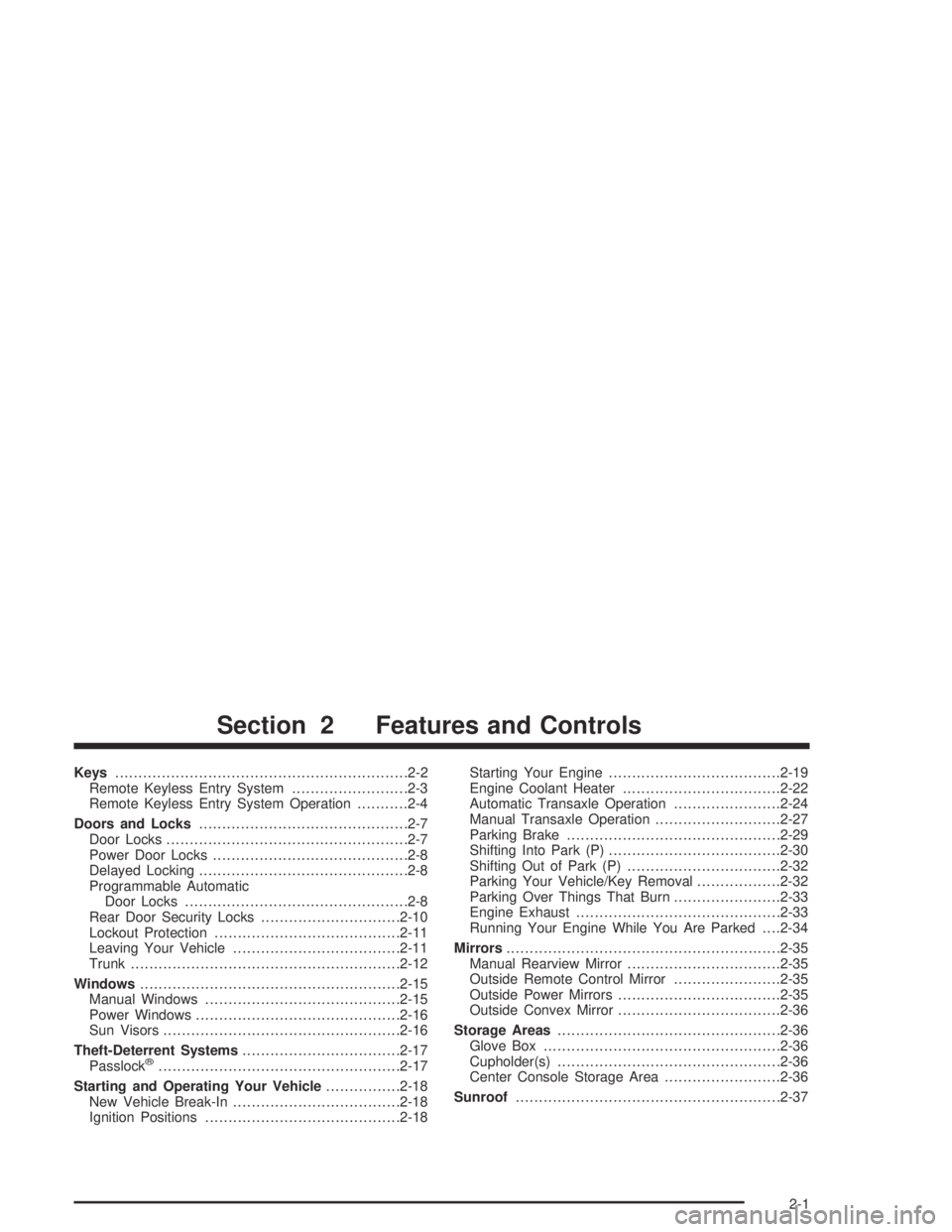
Keys...............................................................2-2
Remote Keyless Entry System.........................2-3
Remote Keyless Entry System Operation...........2-4
Doors and Locks.............................................2-7
Door Locks....................................................2-7
Power Door Locks..........................................2-8
Delayed Locking.............................................2-8
Programmable Automatic
Door Locks................................................2-8
Rear Door Security Locks..............................2-10
Lockout Protection........................................2-11
Leaving Your Vehicle....................................2-11
Trunk..........................................................2-12
Windows........................................................2-15
Manual Windows..........................................2-15
Power Windows............................................2-16
Sun Visors...................................................2-16
Theft-Deterrent Systems..................................2-17
Passlock
®....................................................2-17
Starting and Operating Your Vehicle................2-18
New Vehicle Break-In....................................2-18
Ignition Positions..........................................2-18Starting Your Engine.....................................2-19
Engine Coolant Heater..................................2-22
Automatic Transaxle Operation.......................2-24
Manual Transaxle Operation...........................2-27
Parking Brake..............................................2-29
Shifting Into Park (P).....................................2-30
Shifting Out of Park (P).................................2-32
Parking Your Vehicle/Key Removal..................2-32
Parking Over Things That Burn.......................2-33
Engine Exhaust............................................2-33
Running Your Engine While You Are Parked. . . .2-34
Mirrors...........................................................2-35
Manual Rearview Mirror.................................2-35
Outside Remote Control Mirror.......................2-35
Outside Power Mirrors...................................2-35
Outside Convex Mirror...................................2-36
Storage Areas................................................2-36
Glove Box...................................................2-36
Cupholder(s)................................................2-36
Center Console Storage Area.........................2-36
Sunroof.........................................................2-37
Section 2 Features and Controls
2-1
Page 90 of 364
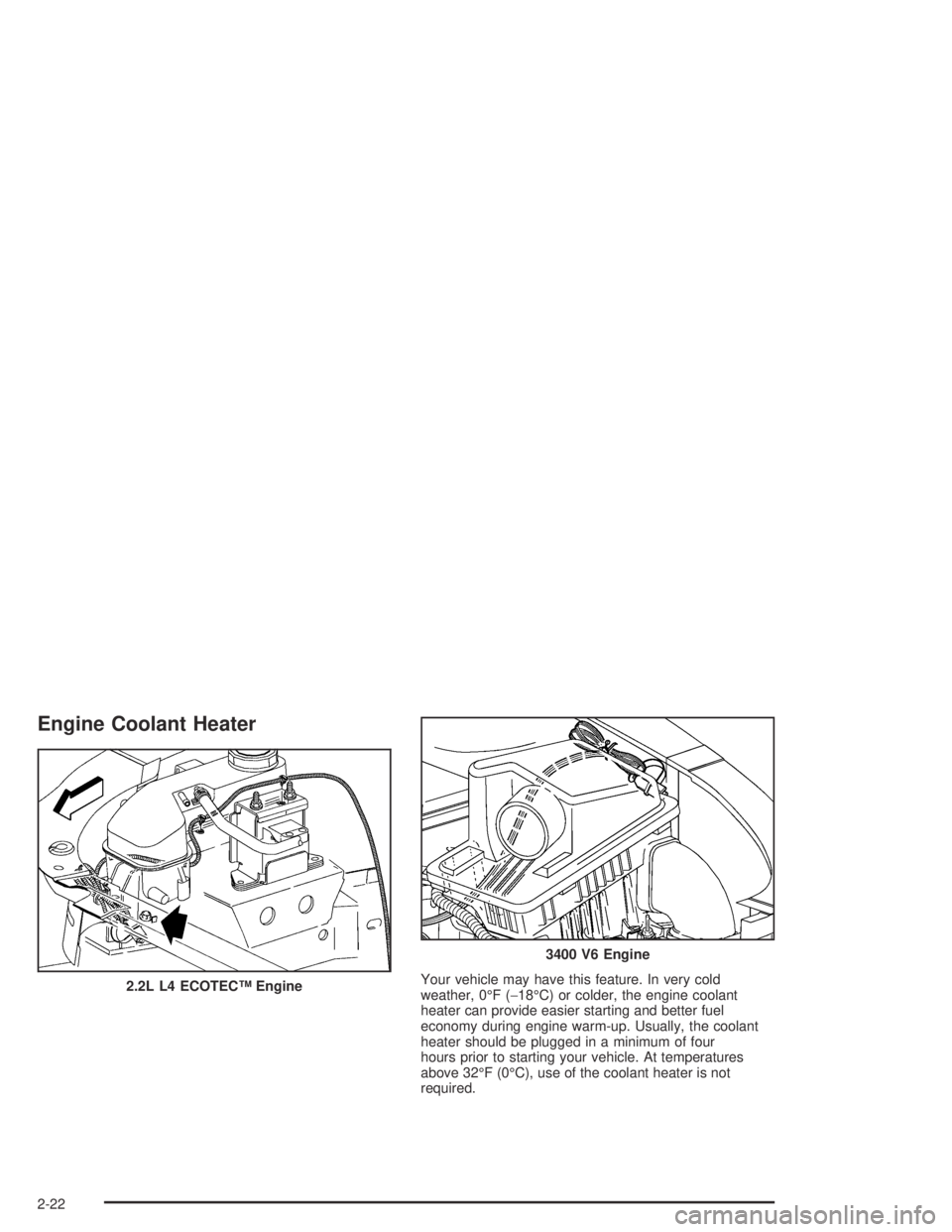
Engine Coolant Heater
Your vehicle may have this feature. In very cold
weather, 0°F (−18°C) or colder, the engine coolant
heater can provide easier starting and better fuel
economy during engine warm-up. Usually, the coolant
heater should be plugged in a minimum of four
hours prior to starting your vehicle. At temperatures
above 32°F (0°C), use of the coolant heater is not
required. 2.2L L4 ECOTEC™ Engine
3400 V6 Engine
2-22
Page 91 of 364

To Use the Engine Coolant Heater
1. Turn off the engine.
2. Open the hood and unwrap the electrical cord. On
the 2.2L L4 ECOTEC™ engine, the engine coolant
heater cord is located in front of the coolant
surge tank on the passenger’s side of the engine
compartment. On the 3400 V6 engine, the
engine coolant heater cord is located near the
engine air cleaner/filter. SeeEngine Compartment
Overview on page 5-12for more information on
location.
3. Plug the cord into a normal, grounded 110-volt AC
outlet.
{CAUTION:
Plugging the cord into an ungrounded outlet
could cause an electrical shock. Also, the
wrong kind of extension cord could overheat
and cause a �re. You could be seriously
injured. Plug the cord into a properly grounded
three-prong 110-volt AC outlet. If the cord will
not reach, use a heavy-duty three-prong
extension cord rated for at least 15 amps.4. Before starting the engine, be sure to unplug and
store the cord as it was before to keep it away
from moving engine parts. If you don’t, it could be
damaged.
How long should you keep the coolant heater plugged
in? The answer depends on the outside temperature, the
kind of oil you have, and some other things. Instead
of trying to list everything here, we ask that you contact
your dealer in the area where you’ll be parking your
vehicle. The dealer can give you the best advice for that
particular area.
2-23
Page 107 of 364
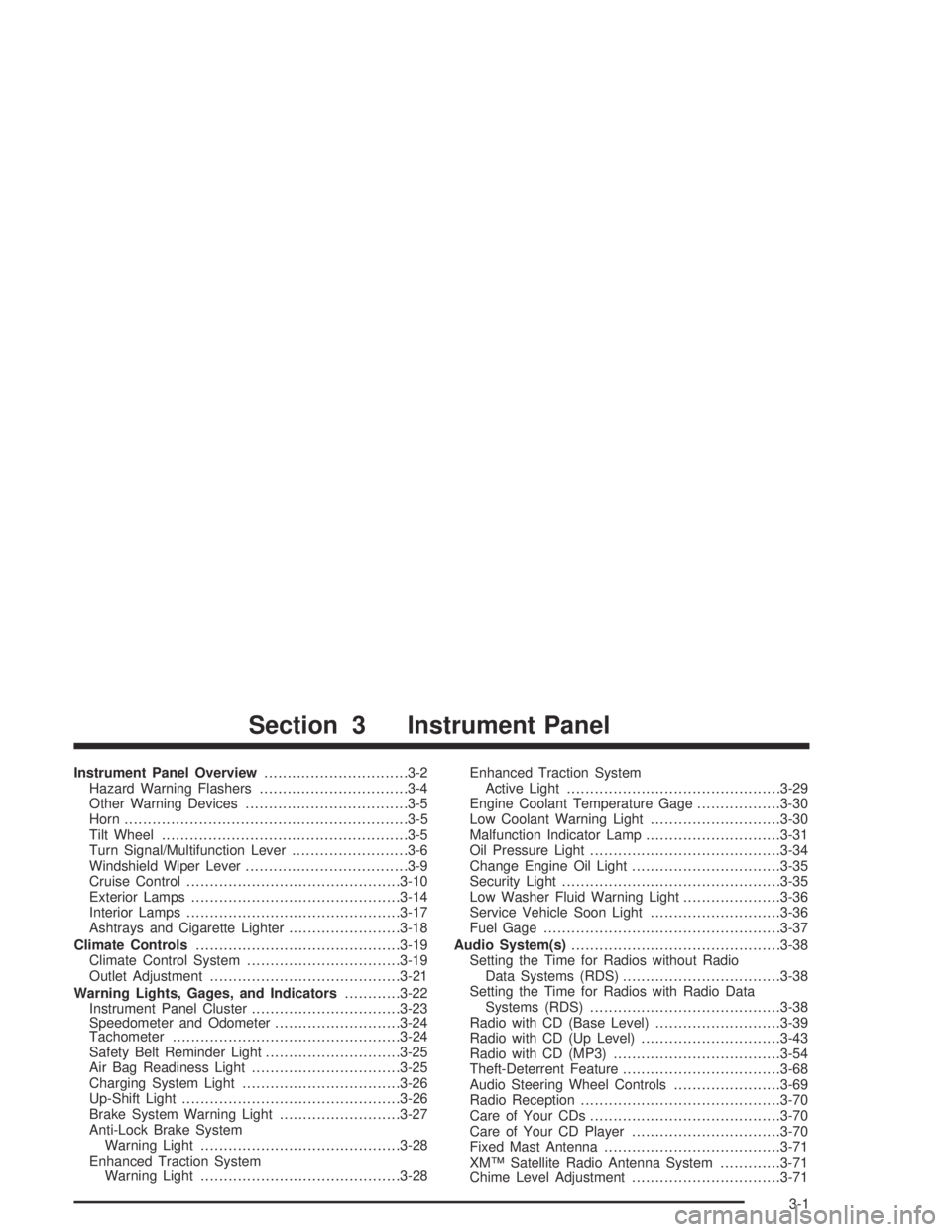
Instrument Panel Overview...............................3-2
Hazard Warning Flashers................................3-4
Other Warning Devices...................................3-5
Horn.............................................................3-5
Tilt Wheel.....................................................3-5
Turn Signal/Multifunction Lever.........................3-6
Windshield Wiper Lever...................................3-9
Cruise Control..............................................3-10
Exterior Lamps.............................................3-14
Interior Lamps..............................................3-17
Ashtrays and Cigarette Lighter........................3-18
Climate Controls............................................3-19
Climate Control System.................................3-19
Outlet Adjustment.........................................3-21
Warning Lights, Gages, and Indicators............3-22
Instrument Panel Cluster................................3-23
Speedometer and Odometer...........................3-24
Tachometer.................................................3-24
Safety Belt Reminder Light.............................3-25
Air Bag Readiness Light................................3-25
Charging System Light..................................3-26
Up-Shift Light...............................................3-26
Brake System Warning Light..........................3-27
Anti-Lock Brake System
Warning Light...........................................3-28
Enhanced Traction System
Warning Light...........................................3-28Enhanced Traction System
Active Light..............................................3-29
Engine Coolant Temperature Gage..................3-30
Low Coolant Warning Light............................3-30
Malfunction Indicator Lamp.............................3-31
Oil Pressure Light.........................................3-34
Change Engine Oil Light................................3-35
Security Light...............................................3-35
Low Washer Fluid Warning Light.....................3-36
Service Vehicle Soon Light............................3-36
Fuel Gage...................................................3-37
Audio System(s).............................................3-38
Setting the Time for Radios without Radio
Data Systems (RDS)..................................3-38
Setting the Time for Radios with Radio Data
Systems (RDS).........................................3-38
Radio with CD (Base Level)...........................3-39
Radio with CD (Up Level)..............................3-43
Radio with CD (MP3)....................................3-54
Theft-Deterrent Feature..................................3-68
Audio Steering Wheel Controls.......................3-69
Radio Reception...........................................3-70
Care of Your CDs.........................................3-70
Care of Your CD Player................................3-70
Fixed Mast Antenna......................................3-71
XM™ Satellite Radio Antenna System.............3-71
Chime Level Adjustment................................3-71
Section 3 Instrument Panel
3-1
Page 125 of 364
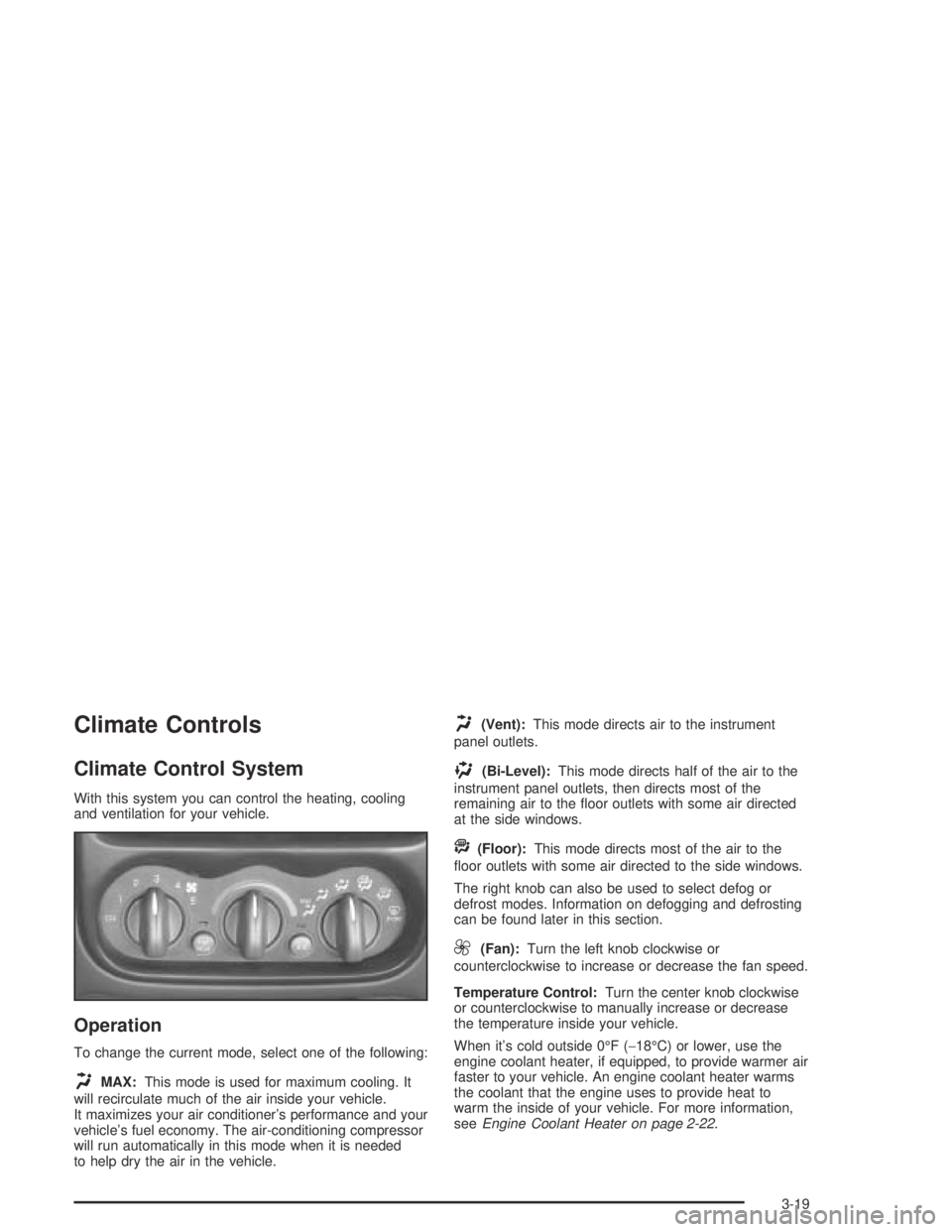
Climate Controls
Climate Control System
With this system you can control the heating, cooling
and ventilation for your vehicle.
Operation
To change the current mode, select one of the following:
HMAX:This mode is used for maximum cooling. It
will recirculate much of the air inside your vehicle.
It maximizes your air conditioner’s performance and your
vehicle’s fuel economy. The air-conditioning compressor
will run automatically in this mode when it is needed
to help dry the air in the vehicle.
H(Vent):This mode directs air to the instrument
panel outlets.
)(Bi-Level):This mode directs half of the air to the
instrument panel outlets, then directs most of the
remaining air to the floor outlets with some air directed
at the side windows.
A(Floor):This mode directs most of the air to the
floor outlets with some air directed to the side windows.
The right knob can also be used to select defog or
defrost modes. Information on defogging and defrosting
can be found later in this section.
9(Fan):Turn the left knob clockwise or
counterclockwise to increase or decrease the fan speed.
Temperature Control:Turn the center knob clockwise
or counterclockwise to manually increase or decrease
the temperature inside your vehicle.
When it’s cold outside 0°F (−18°C) or lower, use the
engine coolant heater, if equipped, to provide warmer air
faster to your vehicle. An engine coolant heater warms
the coolant that the engine uses to provide heat to
warm the inside of your vehicle. For more information,
seeEngine Coolant Heater on page 2-22.
3-19
Page 136 of 364
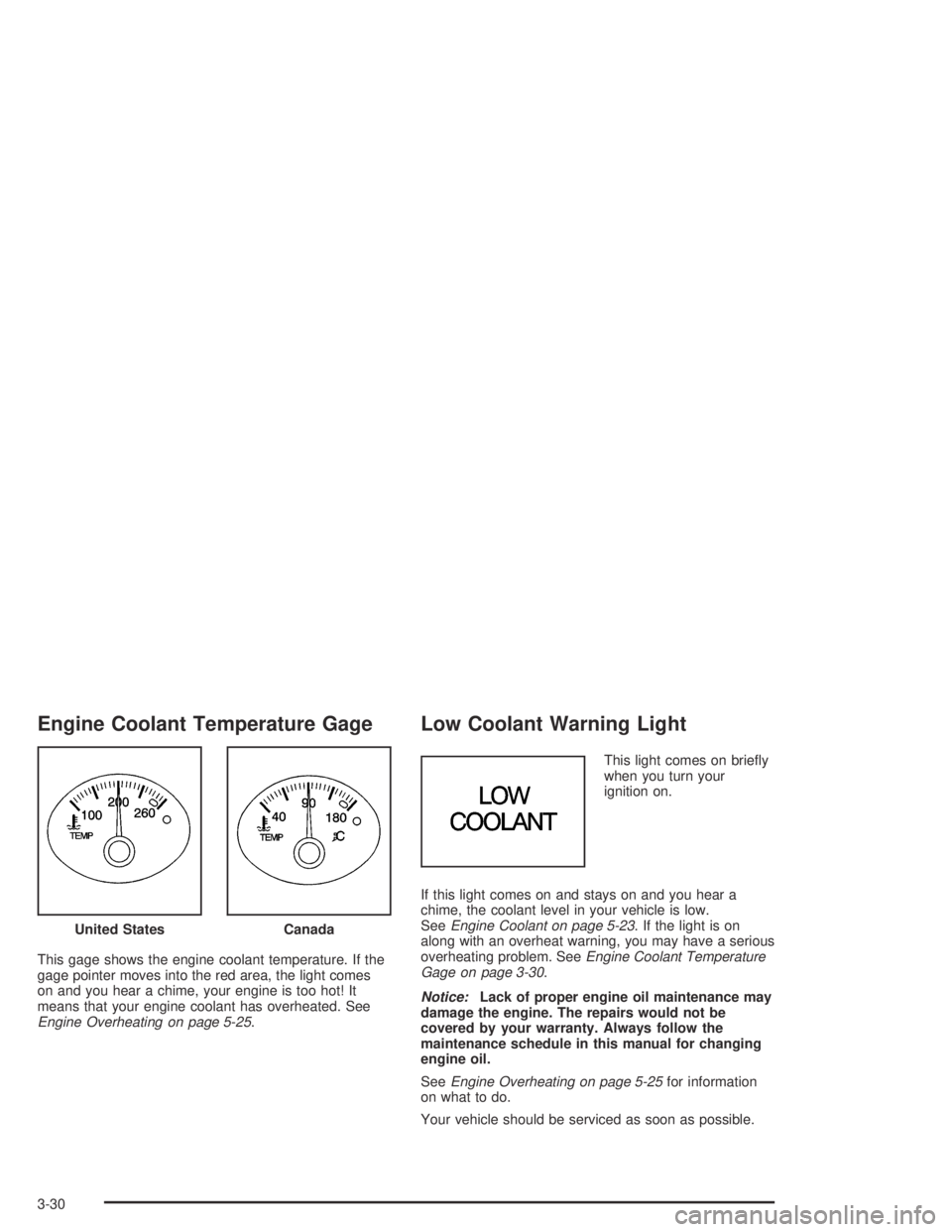
Engine Coolant Temperature Gage
This gage shows the engine coolant temperature. If the
gage pointer moves into the red area, the light comes
on and you hear a chime, your engine is too hot! It
means that your engine coolant has overheated. See
Engine Overheating on page 5-25.
Low Coolant Warning Light
This light comes on briefly
when you turn your
ignition on.
If this light comes on and stays on and you hear a
chime, the coolant level in your vehicle is low.
SeeEngine Coolant on page 5-23. If the light is on
along with an overheat warning, you may have a serious
overheating problem. SeeEngine Coolant Temperature
Gage on page 3-30.
Notice:Lack of proper engine oil maintenance may
damage the engine. The repairs would not be
covered by your warranty. Always follow the
maintenance schedule in this manual for changing
engine oil.
SeeEngine Overheating on page 5-25for information
on what to do.
Your vehicle should be serviced as soon as possible. United States
Canada
3-30
Page 227 of 364
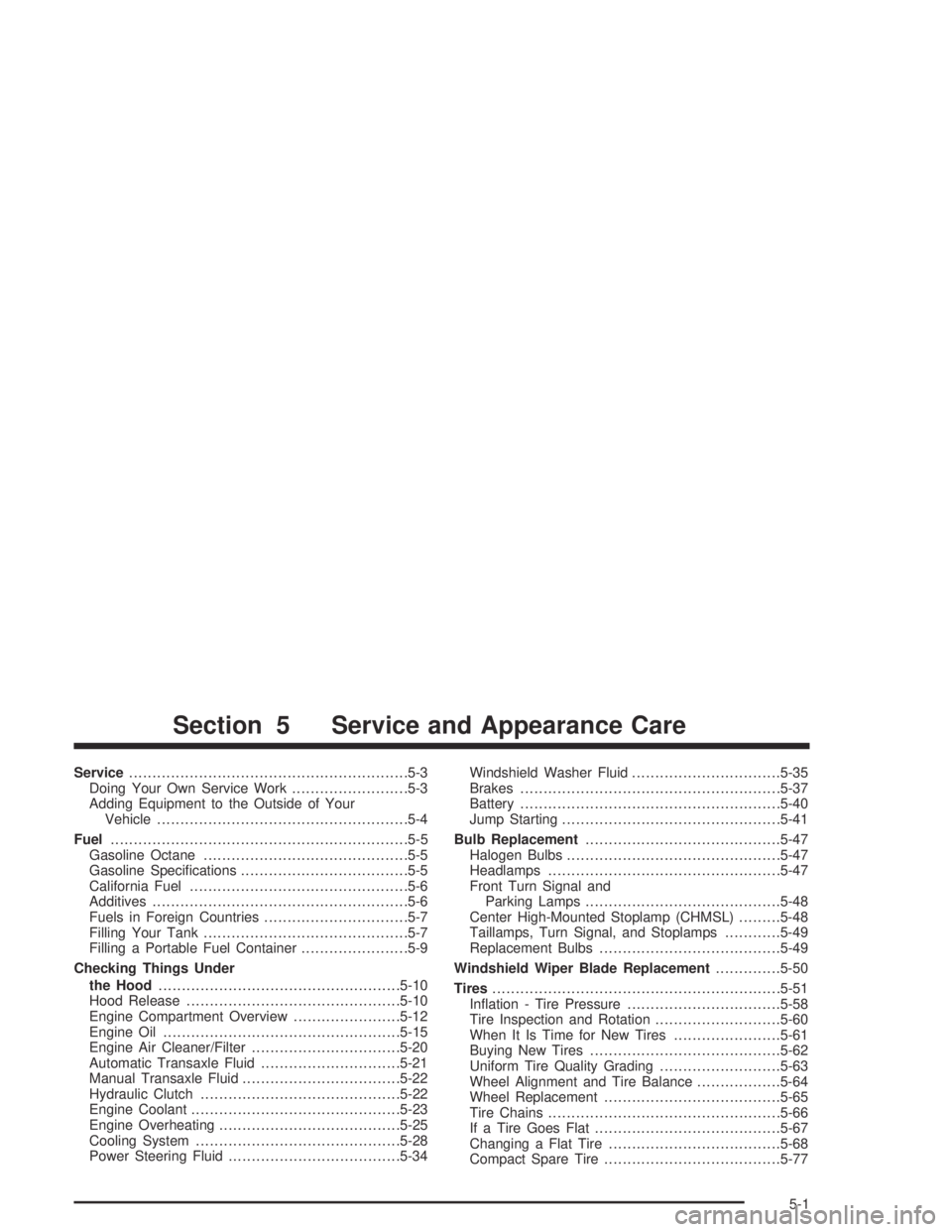
Service............................................................5-3
Doing Your Own Service Work.........................5-3
Adding Equipment to the Outside of Your
Vehicle......................................................5-4
Fuel................................................................5-5
Gasoline Octane............................................5-5
Gasoline Specifications....................................5-5
California Fuel...............................................5-6
Additives.......................................................5-6
Fuels in Foreign Countries...............................5-7
Filling Your Tank............................................5-7
Filling a Portable Fuel Container.......................5-9
Checking Things Under
the Hood....................................................5-10
Hood Release..............................................5-10
Engine Compartment Overview.......................5-12
Engine Oil...................................................5-15
Engine Air Cleaner/Filter................................5-20
Automatic Transaxle Fluid..............................5-21
Manual Transaxle Fluid..................................5-22
Hydraulic Clutch...........................................5-22
Engine Coolant.............................................5-23
Engine Overheating.......................................5-25
Cooling System............................................5-28
Power Steering Fluid.....................................5-34Windshield Washer Fluid................................5-35
Brakes........................................................5-37
Battery........................................................5-40
Jump Starting...............................................5-41
Bulb Replacement..........................................5-47
Halogen Bulbs..............................................5-47
Headlamps..................................................5-47
Front Turn Signal and
Parking Lamps..........................................5-48
Center High-Mounted Stoplamp (CHMSL).........5-48
Taillamps, Turn Signal, and Stoplamps............5-49
Replacement Bulbs.......................................5-49
Windshield Wiper Blade Replacement..............5-50
Tires..............................................................5-51
Inflation - Tire Pressure.................................5-58
Tire Inspection and Rotation...........................5-60
When It Is Time for New Tires.......................5-61
Buying New Tires.........................................5-62
Uniform Tire Quality Grading..........................5-63
Wheel Alignment and Tire Balance..................5-64
Wheel Replacement......................................5-65
Tire Chains..................................................5-66
If a Tire Goes Flat........................................5-67
Changing a Flat Tire.....................................5-68
Compact Spare Tire......................................5-77
Section 5 Service and Appearance Care
5-1
Page 236 of 364

Checking Things Under
the Hood
{CAUTION:
An electric fan under the hood can start up
and injure you even when the engine is not
running. Keep hands, clothing and tools away
from any underhood electric fan.
{CAUTION:
Things that burn can get on hot engine parts
and start a �re. These include liquids like fuel,
oil, coolant, brake �uid, windshield washer and
other �uids, and plastic or rubber. You or
others could be burned. Be careful not to drop
or spill things that will burn onto a hot engine.
Hood Release
To open the hood, do the following:
1. Pull the handle located
under the instrument
panel on the driver’s
side of the vehicle.
5-10
Page 239 of 364

A. Engine Coolant Surge Tank. SeeCooling System on
page 5-28.
B. Ground. SeeJump Starting on page 5-41.
C. Engine Oil Dipstick. See “Checking Engine Oil” in
Engine Oil on page 5-15.
D. Engine Oil Fill Cap. See “When to Add Engine Oil”
inEngine Oil on page 5-15.
E. Brake Fluid Reservoir. See “Brake Fluid” inBrakes
on page 5-37.F. Power Steering Fluid Reservoir. SeePower Steering
Fluid on page 5-34.
G. Engine Compartment Fuse Block. SeeFuses and
Circuit Breakers on page 5-87.
H. Engine Air Cleaner/Filter. SeeEngine Air
Cleaner/Filter on page 5-20.
I. Battery. SeeBattery on page 5-40.
J. Windshield Washer Fluid Reservoir. SeeWindshield
Washer Fluid on page 5-35.
5-13
Page 241 of 364
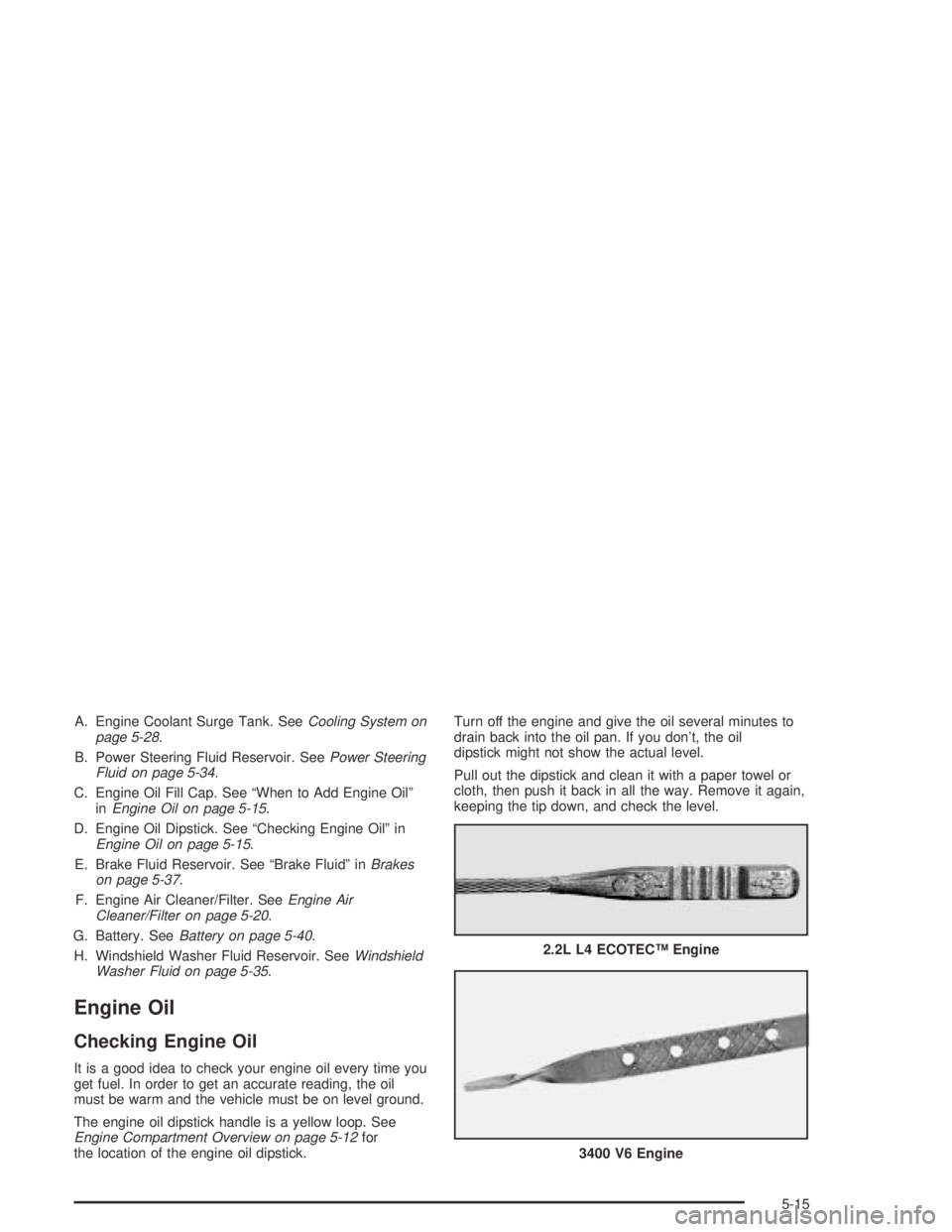
A. Engine Coolant Surge Tank. SeeCooling System on
page 5-28.
B. Power Steering Fluid Reservoir. SeePower Steering
Fluid on page 5-34.
C. Engine Oil Fill Cap. See “When to Add Engine Oil”
inEngine Oil on page 5-15.
D. Engine Oil Dipstick. See “Checking Engine Oil” in
Engine Oil on page 5-15.
E. Brake Fluid Reservoir. See “Brake Fluid” inBrakes
on page 5-37.
F. Engine Air Cleaner/Filter. SeeEngine Air
Cleaner/Filter on page 5-20.
G. Battery. SeeBattery on page 5-40.
H. Windshield Washer Fluid Reservoir. SeeWindshield
Washer Fluid on page 5-35.
Engine Oil
Checking Engine Oil
It is a good idea to check your engine oil every time you
get fuel. In order to get an accurate reading, the oil
must be warm and the vehicle must be on level ground.
The engine oil dipstick handle is a yellow loop. See
Engine Compartment Overview on page 5-12for
the location of the engine oil dipstick.Turn off the engine and give the oil several minutes to
drain back into the oil pan. If you don’t, the oil
dipstick might not show the actual level.
Pull out the dipstick and clean it with a paper towel or
cloth, then push it back in all the way. Remove it again,
keeping the tip down, and check the level.
2.2L L4 ECOTEC™ Engine
3400 V6 Engine
5-15